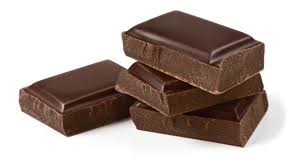 Now this is shocking news for chocolate lovers - that it may be contaminated with lead and cadmium! Maybe it's not so bad for those who rarely eat chocolate, but it's not good for those who really love their chocolate and eat a lot. The group As You Sow did independent laboratory testing of 42 chocolate products for lead and cadmium and found that 26 of the chocolate products (~62%) contained lead and/or cadmium at levels in which one serving exceeds theCalifornia safe harbor level for reproductive harm.From The Washington Post:
Now this is shocking news for chocolate lovers - that it may be contaminated with lead and cadmium! Maybe it's not so bad for those who rarely eat chocolate, but it's not good for those who really love their chocolate and eat a lot. The group As You Sow did independent laboratory testing of 42 chocolate products for lead and cadmium and found that 26 of the chocolate products (~62%) contained lead and/or cadmium at levels in which one serving exceeds theCalifornia safe harbor level for reproductive harm.From The Washington Post:
How much lead is in your chocolate?
If you (like me) have been happily snarfing down chocolate in recent years, secure in the knowledge that those flavonols were at least doing good things for your heart, today is not your day. Just in time for Valentine's Day, a California consumer health watchdog group filed legal notices Wednesday demanding that many of the big chocolate companies post warnings on their packages that show their products contain high levels of lead and cadmium.
As You Sow, an Oakland nonprofit, says single servings of 26 products it tested (three times) contain more of the two harmful heavy metals than allowed under the Golden State's Proposition 65 toxic chemical warning law. Here is the list, which includes many of the big name producers of my favorite food. Try not to weep openly at work.
"We are getting [lead and cadmium] from multiple sources," Eleanne Van Vliet, director of toxic chemicals research for As You Sow, said in an interview. "The problem with those toxic heavy metals is they accumulate in the body. It’s terrible for adults, but especially for children." Overexposure to lead, of course, can cause all kinds of health problems,including lowering children's IQ. Cadmium is a carcinogen and can cause kidney and bone damage.
Now before you ask the boss to remove all the vending machines, let's be clear that the chocolate companies, and the association that represents them, are having none of this. They say there are, at worst, trace amounts of lead and cadmium in chocolate from natural sources and that regulators have rejected this argument before....Van Vliet insists that As You Sow is not talking about tiny amounts; rather, she says, if you think about the amount of chocolate the average person consumes each year, these concentrations are worrisome.If we could get them all in a room, both sides would probably agree on one thing: We do eat a lot of chocolate.
.However, that prompted researchers at the University of California Santa Cruz to look into the amount of lead (but not cadmium) in chocolate, and the results were somewhat sobering. Their study, published in 2005 in the journal Environmental Health Perspectives, concluded that the lead in chocolate was not from naturally occurring sources, a stance that one of the researchers, Russ Flegal, reiterated when I called him.
"The average lead concentration of cocoa beans was ≤ 0.5 ng/g, which is one of the lowest reported values for a natural food," they wrote. "In contrast, lead concentrations of manufactured cocoa and chocolate products were as high as 230 and 70 ng/g, respectively, which are consistent with market-basket surveys that have repeatedly listed lead concentrations in chocolate products among the highest reported for all foods. One source of contamination of the finished products is tentatively attributed to atmospheric emissions of leaded gasoline, which is still being used in Nigeria."
Van Vliet says she doesn't know where the metals come from, only that they may enter the chocolate somewhere in the manufacturing process -- which Flegal said is also possible -- and are at unsafe levels in the chocolate we eat.
 It is great to find a good news study these days, and this one is especially good news for chocolate lovers. Researchers reviewed 6 large studies from the last few decades and found that chocolate consumption more than once a week is associated with a reduced risk of coronary artery disease (CAD).
It is great to find a good news study these days, and this one is especially good news for chocolate lovers. Researchers reviewed 6 large studies from the last few decades and found that chocolate consumption more than once a week is associated with a reduced risk of coronary artery disease (CAD).